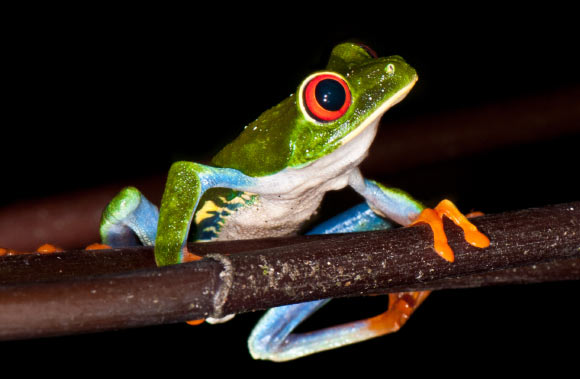Frogs have the ability to see color even when it is so dark that humans are not able to see anything at all, according to a new study published in the journal Philosophical Transactions of the Royal Society B.

According to Yovanovich et al, frogs can see color in extreme darkness, down to the absolute threshold of the visual system. Image credit: Sonja Pauen / CC BY 2.0.
Most vertebrates, including humans, have two types of visual cells located in the retina, namely cones and rods.
The cones enable us to see color, but they usually require a lot of light and therefore stop working when it gets dark, in which case the rods take over so that we can at least find our way home, albeit in black and white.
In toads and frogs the rods are a bit special, however.
It was previously known that toads and frogs are unique in having rods with two different sensitivities.
This has not been found in other vertebrates, and it is also the reason why researchers have long suspected that frogs and toads might be able to see color also at very low light levels.
The new study, led by Dr. Kristian Donner, a researcher in the Department of Biosciences at the University of Helsinki, was first in proving this to be true, and the results exceeded all expectations.
“The hypothesis has never been properly tested, so we performed three behavioral experiments at different light intensities with toads (genus Bufo) and frogs (genus Rana) to determine the thresholds for color discrimination,” Dr. Donner and co-authors said.
It was during the third of three experiments that the researchers discovered that frogs are able to use their rods to distinguish color in extreme darkness.
The researchers studied the frogs in a situation that is as serious as it is common, namely, when frogs need to find their way out in case they are trapped in conditions of complete darkness.
This is potentially an everyday occurrence, taking place in dark dens and passageways on the ground.
In such instances, finding the exit becomes crucial, which also means that the frog is inclined to make use of any sensory information that is available.
In the other experiments the researchers studied to what extent frogs and toads use their color vision when searching for a mate or hunting for food.
The results showed that the animals stop using their color information fairly early when it comes to finding someone with whom to mate, whereas they continue to take advantage of their color vision to select food in such low-light conditions that humans lose their ability to see color.
“The thresholds of toads were different in mate choice and prey-catching tasks, suggesting that the differential sensitivities of different spectral cone types as well as task-specific factors set limits for the use of color in these behavioral contexts,” the authors explained.
“In neither task was there any indication of rod-based color discrimination.”
“By contrast, frogs performing phototactic jumping were able to distinguish blue from green light down to the absolute visual threshold, where vision relies only on rod signals.”
“The remarkable sensitivity of this mechanism comparing signals from the two spectrally different rod types approaches theoretical limits set by photon fluctuations and intrinsic noise.”
“We have previously shown moths and geckos are also able to see color in inferior light conditions compared to humans. However, frogs apparently have a unique ability to see color in the dark,” said Lund University Professor Almut Kelber, co-author on the study.
_____
Carola A.M. Yovanovich et al. 2017. The dual rod system of amphibians supports colour discrimination at the absolute visual threshold. Phil. Trans. R. Soc. B 372 (1717); doi: 10.1098/rstb.2016.0066







